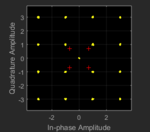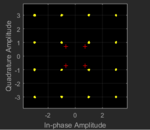r_gomes
Newbie level 6
Hi guys,
I have been struggling for while with this problem and I am not able to solve it. I want to consider a single carrier system with 16 QAM with pulse shaping, until this point the system works just fine. I use a Square Raised Cosine Filter both in TX and RX and I do not get any interference, and thus 0 value of BER.
However whenI add a pseudo random sequence as preamble for channel estimation purposes I do get ISI. I believe the problem is with using different modulation for data and preamble and when I filtered data + preamble the filtering process introduces ISI.
There is anyone that could tell how can I solve this issue? The following picture shows the simulink implementation:

Many thanks,
Rodolfo
I have been struggling for while with this problem and I am not able to solve it. I want to consider a single carrier system with 16 QAM with pulse shaping, until this point the system works just fine. I use a Square Raised Cosine Filter both in TX and RX and I do not get any interference, and thus 0 value of BER.
However whenI add a pseudo random sequence as preamble for channel estimation purposes I do get ISI. I believe the problem is with using different modulation for data and preamble and when I filtered data + preamble the filtering process introduces ISI.
There is anyone that could tell how can I solve this issue? The following picture shows the simulink implementation:

Many thanks,
Rodolfo

